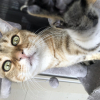So for the first time ever I put a lamp (produces heat, so I thought it would work like a heating lamp at repti stores) over my Tetramorium species e. Atom A formicarium. She has moved some large larvae and her new pupae on the closest side to the heat. I am new at trying heat so I have no idea what's normal behavior and what's not.
Also I tried taking a picture of how the setup was but the light made it hard to see. From the picture, maybe someone could tell me if that's too close or maybe too far?














